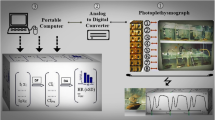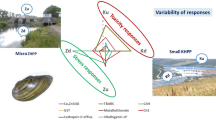Abstract
The characteristics of cardioactivity and the accumulation of metals in the tissues of bivalve mollusks from different water areas of the eastern Gulf of Finland and Rybinsk Reservoirs have been considered. The functional state of the mollusks has been analyzed with the use of original hyperosmotic test impact. An approach is proposed to ranking the quality of freshwater ecosystems by the state of bivalve mollusks dwelling in them.


Similar content being viewed by others
REFERENCES
German, A.V., Zakonnov, V.V., and Mamontov, A.A., Organochlorine compounds in bottom sediments, benthos, and fish in the Volga Pool of the Rybinsk Reservoir, Water Resour., 2010, vol. 37, no. 1, pp. 84–88.
Kozlovskaya, V.I. and German, A.V., Polychlorinated biphenyls and polyaromatic hydrocarbons in the ecosystem of the Rybinskoe Reservoir, Water Resour., 1997, vol. 24, no. 5, pp. 520–526.
Kuznetsova, T.V., Change of salinity of medium as a function loading in estimating functional state of the crayfish Astacus leptodactylus, Zh. Evol. Biochem. Fisiol., 2013, vol. 49, no. 5, pp. 498–502.
Kurakin, A.S., Kholodkevich, S.V., Purvinya, S., Barda, I., Rimsha, E., and Kulinkovich, A.V., Assessing the environmental conditions of Baltic Sea water areas, in Nauch.-tekhn. Vedom. St. Petersb. GPU, Ser. Nauka Obraz., 2012, no. 1, vol. 142, pp. 267–272.
Luk’yanova, O.N., Molekulyarnye biomarkery (Molecular Biomarkers), Vladivostok: Izd. Dalnevost. Gos. Akad. Econ. Manage., 2001.
Martem’yanov, V.I., Effect of the mineral composition of the environment on the characteristics of water–salt exchange of the zebra mussel Dreissena polymorpha Pallas immigrant in the Rybinsk Reservoir, Ros. Zhurn. Biol. Invazii, 2011, vol. 4, no. 2, pp. 120–134.
Makhnev, P.P., Bekrenev, A.V., Baklanov, V.S., Kholodkevich, S.V., Ivanov, A.V., Donchenko, V.K., Kurakin, A.S., Kornienko, E.L., and Fedotov, V.P., A system for ensuring water supply safety at water supply plants of St. Petersburg, Vodosnabzh. Sanit. Tekh., 2006, no. 9, P. 1, pp. 6–15.
Moiseenko, T.I., Ecotoxicological assessment of after-effects of the Volga River water contamination, Water Resour., 2005, vol. 32, no. 4, pp. 369–383.
Moiseenko, T.I., Gashev, S.N., Selyukov, A.G., Zhigileva, O.N., and Aleshina, O.A., Biological methods of water quality assessment: Part 1. Bioindication, Vestn. Tyum. Gos. Univ., 2010, no. 7, pp. 20–40.
Nemova, N.N. and Vysotskaya, R.U., Biokhimicheskaya indikatsiya sostoyaniya ryb (Biochemical indication of Fish State), Moscow: Nauka, 2004.
Trusova, L.N. and Frumin, G.T., Water quality dynamics in the major rivers of Vologda oblast, Ekol. Khimiya, 2012, no. 21, vol. 3, pp. 137–143,
Filenko, O.F., Dmitrieva, A.G., Isakova, E.F., Ipatova, V.N., Prokhotskaya, V.Yu., Samoilova, T.A., and Chernomyrdina, A.V., Response mechanisms of aquatic organisms to the impact of toxic substances, in Antropogennoe vliyanie na vodnye ekosistemy (Anthropogenic Effect on Aquatic Organisms), Moscow: Mosk Gos. Univ., 2005, pp. 70–93.
Flerov, B.A., Ekologo-fiziologicheskie aspekty toksikologii presnovodnykh zhivotnykh (Ecological–Physiological Aspects of Freshwater Animal Toxicology), Leningrad: Nauka, 1989.
Flerov, B.A., Tomilina, I.I., Klivlend, L., Bakanov, A.I., and Gapeeva, M.V., Integral estimate of bottom sediment state in the Rybinsk Reservoir, Biol. Vnutr. Vod, 2000, no. 2, pp. 148–155.
Kholodkevich, S.V., Fiber-optic remote biosensor systems of continuous biological monitoring of surface-water and bottom-sediment quality in real time, Materialy mezhdunar. konf. “Neft’ i gaz arkticheskogo shel’fa–2006” (Proc. Intern. Conf. “Oil and Gas in the Arctic Shelf–2006”), Murmansk: Murm. Mor. Biol. Inst., Kola Nauch. Tsentr, Ross. Akad. Nauk, 2006, pp. 287–296.
Kholodkevich, S.V., Ivanov, A.V., Trusevich, V.V., and Kuznetsova, T.V., Ekotoksikologicheskii biomarker dlya bioindikatsii sostoyaniya vodnykh ekosistem na osnove otsenki adaptatsionnoi sposobnosti obitayushchikh v nikh dvustvorchatykh mollyuskov, DAN Ukraini, 2012, no. 6, pp. 138–142.
Kholodkevich, S., Kuznetsova, T., Trusevich, V., and Donchenko, V., Mollusks determine the environmental health. A system for assessing water quality based on the physiological and behavioral biomarkers of benthic invertebrates and its application in biomonitoring natural waters and wastewaters, VodaMagazine, 2011, no. 5, vol. 45, pp. 40–43.
Kholodkevich, S.V., Kuznetsova, T.V., Trusevich, V.V., Kurakin, A.S., and Ivanov, A.V., Peculiarities of valve movement and of cardiac activity of the bivalve mollusk Mytilus galloprovincialis at various stress actions, J. Evol. Biochem. Physiol., 2009, vol. 45, no. 4, pp. 524–526.
Kholodkevich, S.V., Sharov, A.N., and Kuznetso-va, T.V., Perspectives and problems in the use of bioelectronic systems in monitoring the state of environmental safety in Gulf of Finland water areas, Region. Ekol., 2015, no. 2, vol. 37, pp. 16–26.
Chuiko, G.M., Biomarkers in hydroecotoxicology: principles, methods, and methodology, practice of use, Chapter XV, Environmental Monitoring, Part VIII, Sovremennye problemy monitoringa presnovodnykh ekosistem: Uch. Posobie (Current Problems in Freshwater Ecosystem Monitoring, a Textbook), Gelashvili, D.B. and Shurganova, G.V., Eds., Nizhny Novgorod: Nizhegor. Gos. Univ., 2014.
Chuiko, G.M., Zakonnov, V.V., Morozov, A.A., Brodskii, E.S., Shelepchikov, A.A., and Feshin, D.B., Spatial distribution and qualitative composition of polychlorinated biphenyls and organochlorine pesticides in bottom sediments and bream (Abramis brama L.) from the Rybinsk Reservoir, Inland Water Biol., 2010, no. 2, pp. 193–202.
Shkorbatov, G.L. and Starobogatov, Ya.I., Methods of studies of bivalve mollusks, Tr. Zool. Inst. Akad. Nauk SSSR, 1990, vol. 219.
Ekosistema estuariya reki Nevy: biologicheskoe raznoobrazie i ekologicheskie problemy (Estuarine Ecosystem of the Neva River: Biodiversity and Environmental Problems), Alimov, A.F., Golubkov, S.M., Eds., Moscow: Tovarishchestvo nauch. izd. KMK, 2008.
Attrill, M.J. and Depledge, M.H., Community and population indicators of ecosystem health: targeting links between levels of biological organization, Aquat. Toxicol., 1997, vol. 38, pp. 183–197.
Bamber, S.D. and Depledge, M.H., Responses of shore crabs to physiological challenges following exposure to selected environmental contaminants, Aquatic Toxicol., 1997, vol. 40, pp. 79–92.
Borcherding, J., Ten years of practical experience with the Dreissena-Monitor, a biological early warning system for continuous water quality monitoring, Hydrobiologia, 2006, vol. 556, pp. 417–426.
Cash, K.J., Assessing and monitoring aquatic ecosystem health—approaches using individual, population, and community/ecosystem measurements, Northern River Basins Study Project Rep., 1995, no. 45.
Chen, W.Y., Jou, L.J., Chen, S.H., and Liao, C.M., A real-time biomonitoring system to detect arsenic toxicity by valve movement in freshwater clam Corbicula fluminea, Ecotoxicology, 2012, vol. 21, no. 4, pp. 1177–1187.
Curtis, T.M., Williamson, R., and Depledge, M.H., Simultaneous, long-term monitoring of valve and cardiac activity in the blue mussel Mytilus edulis exposed to copper, Mar. Biol. (Berlin), 2000, vol. 136, pp. 837–846.
Depledge, M.H., Recovery of ecosystems and their components following exposure to pollution, J. Aquat. Ecosyst. Stress Recovery, 1999, vol. 6, pp. 199–206.
Depledge, M.H., Aagaard, A., and Gyorkos, P., Assessment of trace metal toxicity using molecular, physiological and behavioral biomarkers, Mar. Pollut. Bull., 1995, vol. 31, pp. 19–27.
Directive 2000/60/EC of the European Parliament and of the Council of 23 October 2000 establishing a framework for Community action in the field of water policy, Official J. Eur. Communities, L. 327. 22. 12. 2000.
Gubelit, Y., Polyak, Y., Dembska, G., Pazikowska-Sapota, G., Zegarowski, L., Kochura, D., Krivoro-tov, D., Podgornaya, E., Burova, O., and Maazouzi, C., Nutrient and metal pollution of the eastern Gulf of Finland coastline: sediments, macro algae, microbiota, Sci. Total Environ., 2016, vol. 550, pp. 806–819.
Hagger, J.A., Galloway, T.S., Langston, W.J., and Jones, M.B., Application of biomarkers to assess the condition of European saltwater sites, Environ. Pollut., 2009, vol. 157, pp. 2003–2010.
Handy, R.D. and Depledge, M.H., Physiological responses: their measurement and use as environmental biomarkers in ecotoxicology, Ecotoxicology, 1999, vol. 8, pp. 329–349.
Kholodkevich, S.V., Ivanov, A.V., Kurakin, A.S., Kornienko, E.L., and Fedotov, V.P., Real time biomonitoring of surface water toxicity level at water supply stations, J. Environ. Bioindic., 2008, vol. 3, no. 1, pp. 23–34.
Kholodkevich, S.V., Kuznetsova, T.V., Sharov, A.N., Kurakin, A.S., Lips, U., Kolesova, N., and Lehtonen, K.K., Applicability of a bioelectronic cardiac monitoring system for the detection of biological effects of pollution in bioindicator species in the Gulf of Finland, J. Mar. Syst., 2017, vol. 171, pp. 151–158.
Kholodkevich, S., Sharov, A., Nikolic, M., and Joksimovic, A., Bioindication of aquatic ecosystems on the base of the assessment of functional state of freshwater bivalve mollusks biomarkers, Proc. 2015 4rd Mediterranean Conf. Embedded Computing. Budva, Montenegro: MECO, IEEE conf. publ., 2015, pp. 345–348, ISBN 978-9-9409-4364-6.
Kramer K.J.M. and Foekema E.M., The “Musselmonitor®” as biological early warning system, Biomonitors and Biomarkers as Indicators of Environmental Change 2: A Handbook, Butterworth F.M., Gunatilaka, A. and Gonsebatt, M.E., Eds., New York: Springer, 2001, pp. 59–87.
Kuznetsova, T. and Kholodkevich, S., Comparative assessment of surface water quality through evaluation of physiological state of bioindicator species: searching a new biomarkers, Proc. 2015 4rd Mediterranean Conf. Embedded Computing, Budva, Montenegro: MECO. IEEE conf. publ., 2015, pp. 339–344. ISBN 978-9-9409-4364-6.
Razali, N.M. and Wah, Y.B., Power comparisons of Shapiro-Wilk, Kolmogorov–Smirnov, Lilliefors and Anderson–Darling tests, J. Stat. Model. Analyt., 2011, vol. 2, no. 1, pp. 21–33.
Siddal, R., Robotham, P.W.J., Gill, R.A., Pavlov, D.F., and Chuiko, G.M., Relationship between polycyclic hydrocarbon (PAH) concentrations in bottom sediments and liver tissue of bream (Abramis Brama) in Rybinsk reservoir, Russia, Chemosphere, 1994, vol. 29, no. 7, pp. 1467–1476.
Turja, R., Höher N., Snoeijs P., Baršienė J., Butrimavičienė L., Kuznetsova, T., Kholodkevich, S.V., Devier, M.-H., Budzinski, H., and Lehtonen, K.K., A multibiomarker approach to the assessment of pollution impacts in two Baltic Sea coastal areas in Sweden using caged mussels (Mytilus trossulus), Sci. Total Environ., 2014, vol. 473, pp. 398–409.
Wells, P.G., Depledge, M.H., Butler, J.N., Manock, J.J., and Knap, A.H., Rapid toxicity assessment and biomonitoring of marine contaminants—exploiting the potential of rapid biomarker assays and microscale toxicity tests, Mar. Pollut. Bull., 2001, vol. 42, no. 10, pp. 799–804.
ACNOWLEDGMENTS
This study was carried out with the use of equipment of the Resource Center Observatory of Ecological Safety, Science Park, St. Petersburg State University.
Author information
Authors and Affiliations
Corresponding author
Additional information
Translated by G. Krichevets
Rights and permissions
About this article
Cite this article
Kholodkevich, S.V., Sharov, A.N., Chuiko, G.M. et al. Quality Assessment of Freshwater Ecosystems by the Functional State of Bivalved Mollusks. Water Resour 46, 249–257 (2019). https://doi.org/10.1134/S0097807819020064
Received:
Accepted:
Published:
Issue Date:
DOI: https://doi.org/10.1134/S0097807819020064




